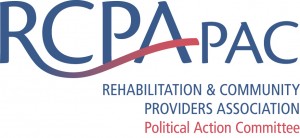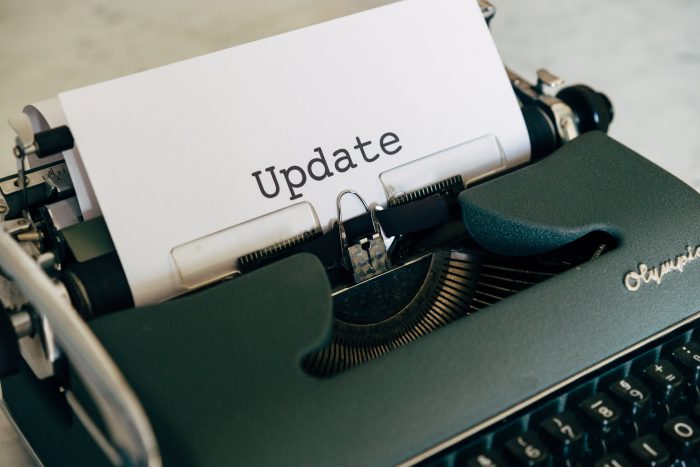Interested in learning about some creative ideas to raise money for RCPA PAC or interested in donating now? Download the PAC FAQ Card, Donation Card, or email Jack Phillips, Director of Government Affairs.

Interested in learning about some creative ideas to raise money for RCPA PAC or interested in donating now? Download the PAC FAQ Card, Donation Card, or email Jack Phillips, Director of Government Affairs.

Now, more than ever, health and human service providers need to be proactive in helping elected officials work towards common sense solutions in the areas of workforce, tax, regulation, health care, and human services.
The Rehabilitation and Community Providers Association Political Action Committee (RCPA PAC) is asking members to help us raise funds — specifically, we are looking for member organizations to raise $1,000 each. Members can raise the $1,000 by doing a number of fun activities and including staff. We need you and your staff to help us reach this goal, because it provides an avenue for our members and staff to make a meaningful impact on the political process. Our goal is to reach this amount by the end of this fiscal year, June 30.
Interested in learning about more fun ideas to raise money for RCPA-PAC or interested in donating now? Please visit our website, download the PAC FAQ Card, Donation Card, or email Jack Phillips, RCPA Director of Government Affairs.
Your participation in the RCPA PAC is completely voluntary and you may contribute as much or as little as you choose. Donations are not tax-deductible and will be used for political purposes. You may choose not to participate without fear of reprisal. You will not be favored or disadvantaged by reason of the amount of your contribution or decision not to contribute.
Capitolwire: Wolf Budget Proposal Spurs Debate on Mental Health Funding
By Robert Swift
HARRISBURG (Feb. 14) — A budget proposal by Gov. Tom Wolf is spurring a new debate about providing more state mental health services during this time of pandemic-related stress.
The governor proposes spending $36.6 million from the taxpayer-supported General Fund in Fiscal Year 2022-23 to restore much of a decade-old cut in state aid to county-run mental health programs.
He would also direct $75 million in federal American Rescue Plan funds for support payments to help keep and hire new employees for qualifying home and community service providers.
A 21-member Mental Health Safety Net Coalition sent a letter Monday to lawmakers asking them to consider the proposed $36.6 million increase as a starting point in budget negotiations.
“The governor’s proposed increase will help offset the loss in purchasing power due to a decade of level funding,” wrote the coalition that includes service providers, hospitals, treatment centers and professional groups. “This money is critical to help counties get back to the effective level of resources they had 10 years ago, but it does not even begin to address all the gaps in our mental health system or surging demand for mental health services as we enter the third year of the global pandemic.”
Not only has the pandemic increased demand for services, it has also led to significant health staff shortages and increases in suicides and opioid deaths, the coalition said.
Also the County Commissioners Association of Pennsylvania issued a statement Monday calling on lawmakers to support Wolf’s proposal. It would restore two-thirds of a 10 percent cut to the budget line item in 2012 if enacted.
“If the funding continues to be uneven with the growing demand, counties will continue to struggle to in meeting the needs of their residents,” said CCAP President and Bradford County Commissioner Daryl Miller.
A key feature of county mental health programs is they are available to the entire community regardless of income, said Brinda Penyak, CCAP deputy executive director.
CCAP made rebuilding a “crumbling” mental health system its top priority this year. For the past six decades, counties have carried the responsibility to provide and contract for a range of community-based mental health services, including crisis intervention, treatment, education and prevention.
“We would strongly support advance planning and (mental health funding) increases that are practical and sustainable to ensure increased system availability for the long term,” said Dr. Kathy Quick, executive director of the Pennsylvania Mental Health Consumer Association while voicing concern that the proposed funding hikes for this year can’t be sustained in the future.
The issue of pandemic-related mental health challenges facing the general population and students as well has been the subject of several legislative hearings during the past two years.
The Senate Agriculture and Rural Affairs Committee held a hearing last month focusing on mental health issues facing agricultural workers. Pennsylvania has received a $500,000 grant from the U.S. Department of Agriculture to provide more resources to support mental health programs in rural areas by linking to national hotline networks and providing education and training, said state Agriculture Secretary Russell Redding at that hearing.

RCPA staff reviewed the Governor’s proposed budget, and while many details still need to be sorted out, RCPA can provide some high-level facts about the proposed budget from the House Democrat Appropriations Committee 2022/23 Executive Budget Proposal At–A-Glance and the Governor’s 2022/23 Executive Budget Spreadsheet. Of note, please see pages 12–13 for the Department of Human Services line items and page 6 for the Department of Drug and Alcohol Programs.
The highlights of the Governor’s proposed budget include:
Education Funding
Economy
Proposed increase to state’s minimum wage to $12 per hour effective July 1, 2022, including tipped workers, with 50 cent annual increases up to $15 per hour ($74.6 million direct revenue increase).
Protecting the Most Vulnerable
In addition to the above proposed funding, the Governor and Democratic legislative leaders support allocating the unused American Rescue Plan funds from last year’s budget to various programs, which are outlined in the Democrat’s American Rescue Plan Act — State Fiscal Recovery plan, to help Pennsylvanians rather than letting the funds be transferred to the General Fund to sit in reserve.
The above information is a high-level overview of the Governor’s budget proposal. The specific line items contained in the Governor’s 2022/23 Executive Budget Spreadsheet are the overall dollars allocated for health and human services. The Department of Human Services (DHS) has not yet released their Budget Blue Book, which breaks down these line items and provides a detailed dollar amount allocated to specific human service programs. We are being told the DHS Blue Book should be available with this specific information at the end of February or the first week of March. Once RCPA obtains the Blue Book and reviews it, we will provide members with a more detailed summary and analysis.
As a reminder, the Governor’s Proposed Budget is just that: a proposal. The General Assembly will now hold budget hearings; a complete hearing list can be found here. The General Assembly and the Governor will conduct budget negotiations after the House and Senate budget hearings conclude to hopefully finalize the Commonwealth’s 2022/23 budget by June 30. If you have any questions, please contact Jack Phillips.
Today, RCPA staff watched the Governor’s budget address and attended the Department of Human Services (DHS) 2022/23 Budget Overview webinar. After listening to the Governor and DHS, there were some positive takeaways for RCPA members. Specifically, the Governor is requesting:
The Governor also proposed increasing the state’s minimum wage to $12 per hour effective July 1, 2022, including tipped workers, with 50 cent annual increases up to $15 per hour ($74.6 million direct revenue increase).
The above are some highlights from both the Governor’s budget request and the DHS presentation. While some of the Governor’s asks may seem beneficial to members, RCPA staff will be reviewing the more detailed spreadsheets we received from the Governor’s office. Once RCPA staff have had the opportunity to review and analyze these spreadsheets, members will receive a more detailed analysis of the Governor’s budget requests. RCPA plans to have the analysis done as soon as possible, so members can get a clearer picture. If you have any questions, please contact Jack Phillips.
